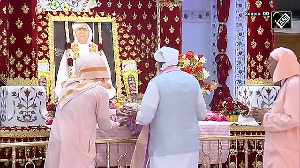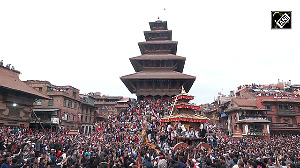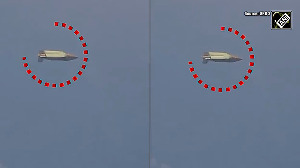But in a world where brand managers lose sleep over the wrong shade of pink in their stamp-size logo for a print campaign, why is the company taking pains to ensure all the logos of its soon-to-be-seven boutique hotels are in different colours?
So much so that even induction presentations to new employers make a point to cover the subject in great detail. Why this quest to be different when everyone else is vehemently protecting their logos' uniformity?
"We are committed to our livery, too," defends Priya Paul, president, The Park Hotels, and director, Apeejay Surrendra group. "Like everyone else, we too have an entire manual about the logo dimensions, the colours, the font size and type - only, to make sure the difference is followed to the T."
But run your eye through the logos above and they are almost identical. Look closely and you realise that the similarity ends with the form of the livery.
For each of the five existing properties, the coloured "threads" on top of the hotel name are a match of carefully chosen colours.
Thus, if The Park in Delhi has the colours yellow, red and green, in Chennai it changes to brown, yellow, and green; in Vishakhapatnam it is orange, yellow and blue; two shades of green and yellow in Bangalore; and pink, orange and blue in Kolkata.
The change happened when the hotel chain felt the need to have a logo type that was both simple and versatile. "The idea was to create something that reflects the urban landscape of the city the hotel is in and, at the same time, talks about the corporate identity of the property," clarifies Paul.
This is not the first time The Park has attempted such a change. Since the 1960s, the chain has changed its logo thrice. And each time, claims the company, it was to highlight a different facet about the hotels, which was also in keeping with the times.
But this time, the company brought out the big guns: it commissioned Conran & Partners, the British design consultancy started by style guru Sir Terence Conran, for the project.
"Our aim was to present each property as individual siblings rather than globally generic corporate clones," says Sebastian Conran, creative director, Conran & Partners.
After a couple of experiments by the designers - which included liveries "Peacock" and "Hot pink", graphic styles of a seven-point star and the @ symbol - which The Park turned down as not neutral or international enough, Conran & Partners picked up the thread from Bangalore. Literally. The designers had designed something similar for The Park at Bangalore during the dotcom boom, which displayed computer cable-like strands.
"The threads can symbolise a number of things," points out a company executive, "silk threads, cables, abstract art, or even DNA!"
Using the threads as its starting point, the design agency conducted extensive research on the various colour palettes reflecting the spirit, vibrancy and history of each city.
Thus, Delhi is all about sandstone architecture (red), summer (yellow) and the green belt in the Lutyen's Zone (green). Three shades of green signify the silk, software and palm leaves of Bangalore; Chennai means brick (orange), bamboo scaffolding and palm, which are represented by two greens, and so on. And through all of them runs a deep blue - the colour the company chose as its corporate identity - strand, which binds them together.
The new colour schemes are used in everything that should bear the hotel logo - from stationery and guest communication to corporate advertising, external signage and marketing.
But the moot point is: Will the guests and visitors to the hotels in different cities notice the difference? Is the subliminal advertising too subliminal to be noticed?
"Brands today need to be personalised and reasonably customised," says Harish Bijoor, brand consultant and CEO, Harish Bijoor Consults Inc, "At the same time, unless there is a certain degree of investment in the percolation of the message, the entire project may end up being just an internal exercise."
The Park's management dismisses such fears. "With the punchline that says 'Stay inspired', do you really think we will stop at the logos?" quizzes Paul. For instance, The Park, Chennai, was once Gemini Film Studios.
The hotel retains the cinematic flavour, from movie posters in rooms to regional movies being screened in the lobby to digital art projects in the passageways to movie countdowns displayed on carpets.
Each property tries to stand out, whether it's through the elaborate coconut or mangoes arrangement in the lobby in Chennai, the marigolds in New Delhi's Fire restaurant, or an aquarium instead of exotic flowers as the centrepiece for the conference table in Bangalore.
Does it work? Here's a quick test: what three colours stand for your city?
Read The Signs
1960s: It was all about service back then. The new logo tried to reflect that, while the typestyle was in sync with the trendy look in vogue back then.
1980s: Highlighting the USP of each hotel, the new logo was a combination of four arrows leading to a centre, implying central location. The catchline: Best located luxury hotels.
1995: This was the no-frills, stick to the business era. So the logo was just that - a logo.








 © 2025
© 2025